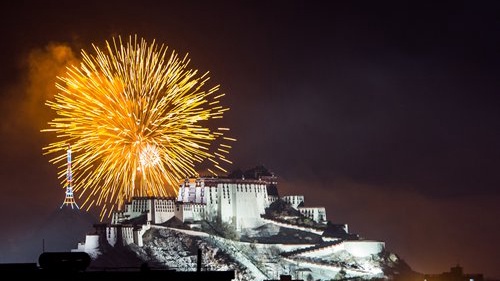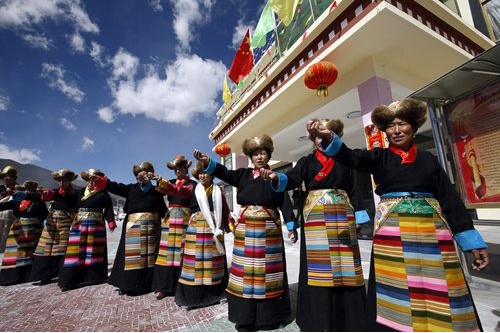


While the excitement of the Spring Festival holidays is finally fading, another wave of excitement is just starting to spread through the bustling streets of Lhasa, capital of Southwest China's Tibet Autonomous Region.
Stalls filled with butter sculptures as well as traditional Tibetan snacks and goods are now springing up in Lhasa's markets to welcome Losar, the Tibetan New Year.
Losar falls on February 27 this year. The most important festival for China's Tibetan ethnic minority, the holiday is celebrated for 15 days, during which time Tibetans pay tribute to Tibetan Buddhist gods and engage in many folk festivities.
Tibetan calendarThe Tibetan calendar was established more than 1,000 years ago. This calendar also includes what is known as a "Rab-byung," a 60-year cycle that is very similar to the sexagenary jiazi cycle used in the calendar that is most widely used in other parts of China.
Also divided into four seasons, a year in the Tibetan calendar consists of 354 days and 12 months, or 13 months when including a leap month. Months are either 29- or 30-days long.
Throughout its development, the Tibetan calendar has absorbed elements from other calendars. For example, during the Tibetan Empire (7th-9th century), the Tibetan calendar began making use of elements from the zodiac signs used in traditional Chinese culture. Each month in the Tibetan calendar is named after one of these 12 zodiac signs, so the first month is "rat," the second is "ox," the third is "tiger" and so on.
In its current state, the Tibetan calendar is a combined lunar-solar calendar that can help predict meteorological phenomenon during different times of the year and track solar and lunar eclipses.
Two-week celebrationSimilar to the Han ethnic majority, Tibetans traditionally have a family reunion dinner on Tibetan New Year's Eve. However, at this gathering they traditionally eat "Guthuk," a porridge-like dish made from balls of dough containing different fillings.
This dish's name is related to Tibetan New Year's Eve, or the 29th of the 12th month. In Tibetan "gu" means "nine" and so represents the 29th, while "thuk" refers to the cooked wheat from which the balls of dough are made.
Fillings for these dough balls are made from nine different ingredients including dried cheese and various grains. Additionally, various items are also hidden inside some dough balls, such as chili peppers, salt, wool, rice and coal. Each of these items symbolizes a type of personality - stone stands for cruelty, wool for someone who is soft-hearted, chili for an unforgiving person, charcoal for an evil mind and a coin for someone who is good with money.
The following morning, housewives will fetch a bucket of water from a river or a well. The family that gets the first bucket of water is supposed to have good luck for the rest of the year.
In more pastoral areas, the first meal of the day is traditionally cooked sheep heads. Wives wake up early in the morning and boil heads for each member of the family. These heads are presented to the eldest male of the family, who then distributes them according the age of the family members.
The second day of the new year is for visiting friends and relatives. When receiving guests, the host carries a colorful box filled with snacks called a "Qemar" while the hostess uses a copper kettle to toast guests.
Praying to the Roof God falls on the third day, during which time people will replace the prayer flags on the roofs of their homes with new ones. The older prayer flag is carried to a nearby mountaintop to pray for good luck for the new year.
The Roof God is the god of reproduction and a small statue of this good is usually found on the edges of roofs. Locals believe this god can not only help families have more children, but also drive away evil spirits.
Monlam, the biggest religious festival in Tibet, kicks off on the fourth day and lasts until the 15th day. During the festival, monks from the Drepung, Sera and Ganden monasteries, the three main monasteries in Tibet, gather at the Jokhang Temple to pray to the Sakyamuni Buddha.
On the last day of celebrations, villagers dress up to attend a spring ploughing ceremony. Cattle are decorated with colorful flags on their horns and ribbons on their tails, while satin is tied to the ox yoke.
Modern adaptations"We used to walk to the nearest mountain from our home, about 10 kilometers away, but now things are different. We can drive there," Kelsang, a Tibetan woman, told the Tibet Daily in a news report published on tibet.cn on February 15.
According to Kelsang, there have been even greater changes. In the past, people used to dance the traditional "gzhaschen" during the day only, returning home when night falls. Now young people head to dance halls to keep on dancing and disco has become a favorite.
While traditionally people used to visit their neighbors and relatives one by one to trade New Year blessings, "Now we use telephone and WeChat," Kelsang said.
According to an article published on tibet.cn on February 10, buying potted plants has also become popular during the Tibetan New Year now that railways and airlines have easy access to Tibet.
Additionally, following in the footsteps of the Spring Festival holidays, elders in some Tibetan families will give red envelopes full of money to children, while red envelope battles have begun taking place on WeChat during Tibetan New Year's Eve.



